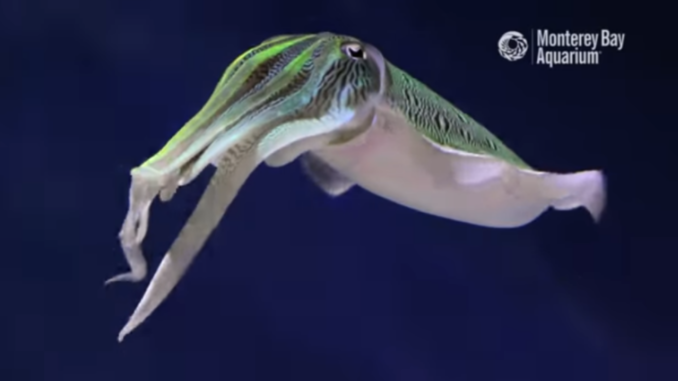
The wide and wild diversity of life on this planet never ceases to amaze and captivate. Take cephalopods for instance. The class Cephalopoda, which includes the cuttlefish, nautilus, octopus, and squid, are intelligent molluscs with very large brain-to-body size ratios.
Besides being smart (some say as smart as a human child), cuttlefish (also called cuttles) can change colors like a chameleon to blend in with its surroundings and camouflage itself in order to hide from predators as well as to conceal itself while hunting or waiting for prey to ambush. The ability to change colors is also employed to woo a mate and compete against rivals. There are more than 120 species of cuttlefish, most of which measure 15 – 25 centimeters (6 – 10 inches), although the largest may measure up to 25 centimeters (20 inches) long (mantle only) and weigh up to 10.5 kilograms (23 pounds).
Their diet typically consists of crab, shrimp, fish, worms, octopus, and small molluscs including other cuttlefish. Cuttlefish are known to change their skin color quickly in a pattern that hypnotizes prey. They catch their meals by either laying in wait for dinner to wander by, or by slowly moving along the bottom until they spot dinner hiding in the sand. Once dinner is targeted, cuttles shoot a jet of water at it to flush it out of hiding, followed quickly by two long tentacles that dart out like a pair of frog’s tongues to grab the victim before it escapes. The tentacles quickly retract, pulling the prey into the grasp of the cuttlefish’s eight short arms which are equipped with suckers to ensure the meal doesn’t get away. The victim is then pulled in to the cuttlefish’s beak and paralyzed with venom before being eaten. It’s like a scene from Aliens, only better.
Those tentacles that shoot out to grab prey are a certain length which cuttles knows very well. If cuttles releases the tentacles too soon before the prey is within striking distance, dinner gets away. Scientists at the University of Minnesota wanted to know how the cuttlefish knew when to strike. Somehow the creature was able to judge distance. The question was, did cuttles use stereopsis to gather depth perception the way that humans do? In humans, the brain can detect the difference between what the right eye sees and what the left eye sees, and automatically estimates the distance to the object in view. That’s stereopsis.
To find out, the researchers glued velcro to the animal’s mantle, just behind the eyes. This provided a convenient way to attach and detach 3-D glasses (with one red lens and one blue lens, just like at the movies). The scientist placed a screen next to cuttles’ water tank and projected a 3-D image of a shrimp to entice the cuttlefish to strike. Sometimes the 3-D shrimp was rendered to appear closer to the cuttlefish than the glass wall of the water tank. In those cases, cuttles struck ‘too soon’ and hit nothing. Other times, the animated shrimp was rendered to appear to be farther away, outside the glass wall. In those cases, cuttles’ tentacles hit the glass wall. The experiment proved that cuttlefish do in fact rely on stereopsis for depth perception.
In another experiment, scientists at the Marine Biological Laboratory in Woods Hole, Massachusetts, tested the cognitive abilities of cuttlefish for self-control and delayed gratification. First, a group of test subjects were trained to understand the meaning of symbols on doors that the cuttlefish could see led to food. A circle on a door indicated the door would open right away. A triangle on a door meant the door would not open for anywhere between 10 to 130 seconds. A square on a door meant it would never open, although this symbol was only used in the control group.
Shrimp, the cuttles preferred food, was placed behind the triangle (and behind the square for the control group). A prawn was placed behind the circle. If a cuttlefish went for the prawn first, the shrimp was immediately removed. In this way the cuttles learned that the only way they could get their favorite food was to be patient and wait until the door with the triangle opened. Researchers found that all the animals would wait at least 50 seconds and some up to 130 seconds to get their shrimp. This exhibit of self-control and delayed gratification is comparable to what crows, ravens, parrots, chimps, and young human children are capable of.
As an aside, it’s worth noting that some people keep cuttlefish as pets. In a home aquarium, of course.
“Kisslip Cuttlefish Changing Colors In Inkredible Mating Displays! | The Critter Corner” (1:39):
“Cuttlefish given 3D glasses to determine how they judge distance” (1:19):
File this last video under “I did not see this coming”. I’ll let the ever-exuberant Caitlyn Hofmeister explain. You’ll never guess, and it’s fascinating stuff.
“Spacecraft Need New Heat Shields. Cue the Cuttlefish?” (4:50):
Question of the Night: Do you have the patience and will power of a cuttlefish?
